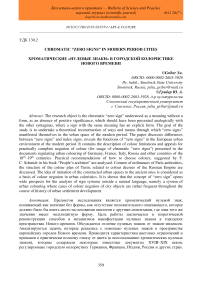Chromatic “zero signs” in modern period cities
Автор: Griber Yuliya
Журнал: Бюллетень науки и практики @bulletennauki
Рубрика: Искусство и культура
Статья в выпуске: 12 (25), 2017 года.
Бесплатный доступ
The research object is the chromatic “zero sign” understood as a meaning without a form, as an absence of positive significance, which should have been presented analogically with the other syntagmas, where a sign with the same meaning has an explicit form. The goal of the study is to undertake a theoretical reconstruction of ways and means through which “zero signs” manifested themselves in the urban space of the modern period. The paper discusses differences between “zero signs” and index signs, reveals the functions of “zero signs” in the European urban environment of the modern period. It contains the description of colour limitations and appeals for practically complete negation of colour (for usage of chromatic “zero signs”) presented in the documents regulating urban colouring of Germany, France, Italy, Russia and other countries of the 18th-19th centuries. Practical recommendations of how to choose colours, suggested by F. C. Schmidt in his book “People’s architect” are analysed. Content of ordinances of Paris authorities, the structure of the colour plan of Turin, related to colour decrees of the Russian Empire are discussed. The idea of imitation of the constructed urban spaces to the ancient ones is considered as a basis of colour negation in urban coloristics. It is shown that the concept of “zero sign” opens wide prospects for the analysis of sign systems outside a natural language, namely a system of urban colouring where cases of colour negation of city objects are rather frequent throughout the course of history of urban settlement development.
Colour, city, urban coloristis, sign, "zero" sign, modern period
Короткий адрес: https://sciup.org/14111402
IDR: 14111402 | УДК: 130.2 | DOI: 10.5281/zenodo.1116413
Список литературы Chromatic “zero signs” in modern period cities
- Saussure de F. Grundlagen der allgemeinen Schprachwissenschaft. Berlin: W. de Gruyter & Co, 1967. 294 S.
- Балли Ш. Общая лингвистика и вопросы французского языка: перев. с франц. Е. В. Вентцель и Т. В. Вентцель. М.: Иностранная литература, 1955. 416 с.
- Bergson H. Creative Evolution. New York: Dover Publications, 1998. 432 p.
- Грибер Ю. А. Цветовые репрезентации социального пространства европейского города. М.: Согласие, 2013. 480 с.
- Rieger H. J. Die farbige Stadt: Beiträge zur Geschichte der farbigen Architektur in Deutschland und der Schweiz 1910 -1939. Zürich: aku Fotodruck, 1976. 316 S.
- Behne A. Das bunte Magdeburg und die Miama. Seidels Reclam. 8. Jg. 1922/23. S. 201-206.
- Пирс Ч. С. Избранные философские произведения. М.: Логос, 2000. 448 с.
- Rasmussen S. E. Experiencing Architecture. Cambridge: MIT Press, 1959. 245 p.
- Semper G. Kleine Schriften. Nachdr. der Ausg. Berlin 1884. Hildesheim; Zürich: Olms-Weidmann, 2008. 516 S.
- Schmidt F. C. Der bürgerliche Baumeister, oder Versuch eines Unterrichts für Baulustige. Bd. 1. Gotha. 1790. 315 S.
- Porro R. Couleure et architecture, une longue histoire//Architecture interieure CREE. 1979. №171. P. 67-68.
- Brino G., Rosso F. Il Piano del colore di Torino 1800-1850. Milano: Idea Books Edizioni, 1980. 135 p.
- Brino G., Rosso F. Colore e citta’. Il Piano del colore di Torino 1801-1863. Milano: Idea Books Edizioni, 1987. 192 p.
- Brino G. Introduction to a dictionary of colours of Italian cities//Colore. Quaderni di Cultura e Progetto del Colore. Notebooks of Culture and Colour Design. 2010. №68. P. 32-46.
- Грибер Ю. А. История цветового проектирования городского пространства: сборник документов и материалов. Смоленск: Изд-во СмолГУ, 2015. 350 с.
- Серов Н. В. Цвет культуры: психология, культурология, физиология. СПб.: Речь, 2004. 672 с.
- Winkelmann J. J. Geschichte der Kunst des Alterthums. Mit einer Einführung von Wilhelm Waetzoldt. Berlin: Safari-Verlag, 1942. 439 S.


